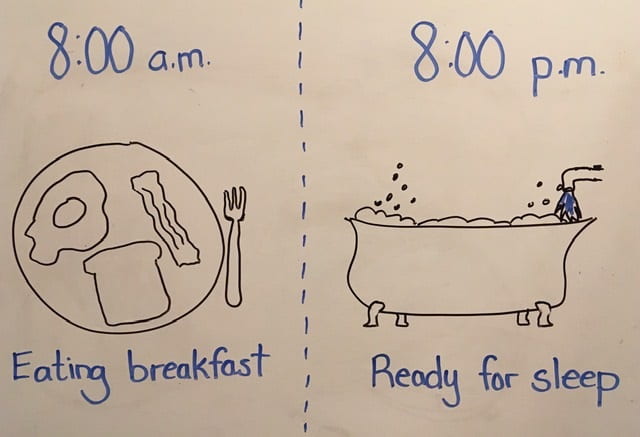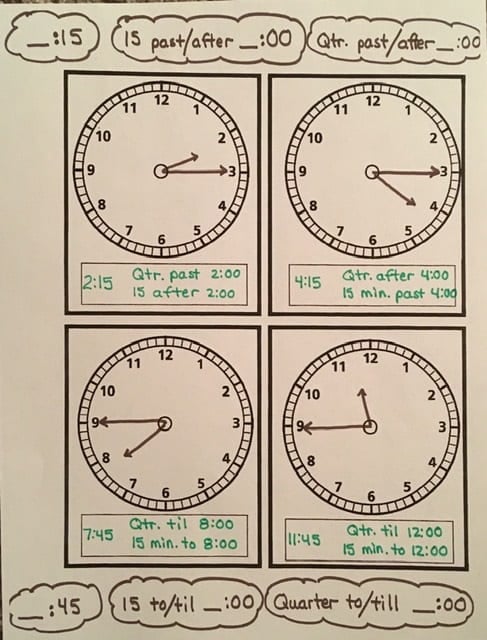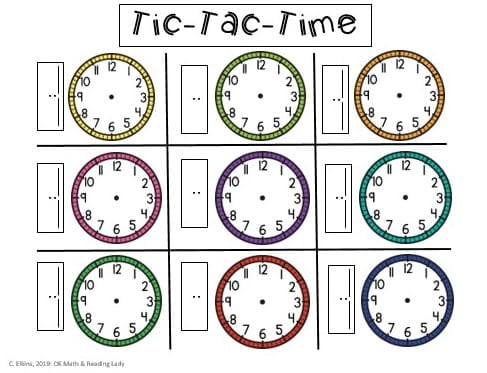by C. Elkins, OK Math and Reading Lady
In this post, I will present some ideas for reading and drawing clock times (especially the analog): to the hour, half hour, quarter hour, and 5 minute increments. Along with practice telling time should be opportunities to put it in context. For example, While setting the clock for 8:00, I would mention that at 8:00 in the morning I might be getting ready for school or eating breakfast, while at 8:00 at night I might be doing schoolwork, watching tv, or getting ready for bed. Look for some freebies throughout this post!
Time to the hour:
- Short hand / short word = hour
- Long hand / longer word = minutes
- Use an anchor chart to show a large clock and label the hands.
- Always look for the short hand first when naming time to the hour.
- Show with a Judy clock or the clock on https://www.mathlearningcenter.org/resources/apps/math-clock. Observe what happens to the hour hand when the minute hand moves all the way around the clock one time. Admittedly, this is a hard concept for kids because we are imitating an hour in time in only a few seconds. And no one has time to watch the clock for an hour!!
- Discuss what events take about an hour to accomplish (see Telling Time Part 1 for more info).
- Draw pictures to show 2 different times of day with the same time (8:00 in the morning, 8:00 in the evening)
- If you want students to practice drawing a clock correctly with the hour notations, try it in the steps shown above.
Time to the half-hour:
- Shade half of the clock
- Show the position of the hour hand when it is half-past the hour. It should be positioned half way between the 2 hour numbers. I usually show students you should be able to tell the approximate time even if the minute hand was missing based on where the hour hand was located between two numbers. So when students are drawing hands to show 7:30, help them see the hour hand will be half-way between the 7 and the 8.
- Brainstorm events which take about 30 minutes to accomplish.
- During the morning or afternoon, announce each time 30 minutes has passed.
**For 3rd and up, start looking at what 30 minutes of elapsed time looks like on a clock. The minute hand will be directly opposite where it started out. For example: 3:40 + 30 minutes = 4:10. The minute hand would change from the 8 to 2 which cuts the clock in half.
Time to the quarter hour:
- Practice dividing a circle into fourths (vertical and horizontal lines) and label with 12, 3, 6, and 9.
- Label your classroom clock with 15, 30, and 45 next to the 3, 6, and 9. Here’s a freebie from “Dr. H’s Classroom” on TPT: Clock labels – FREE
- 15 minutes is a fourth of 60. Or 15 + 15 + 15 + 15 = 60. Check that students aren’t confusing it with 25 minutes (since 25 cents is a quarter dollar). Remind students that “quart” is common in many terms: quarter (4 in a dollar); quartet (4 singers); quart (4 of them in a gallon); quarter in sports (one fourth of the game).
- Brainstorm events that might take about 15 minutes to accomplish.
- Check out my Time to the Quarter Hour lesson practice and game below.
- 8:15 — eight fifteen, quarter past 8, 15 past 8
- 8:30 — eight thirty, half past 8, 30 minutes past 8, 30 minutes until 9:00
- 8:45 — eight forty-five, 45 minutes after 8, 15 minutes til 9:00
Here are two FREE activities to practice time to the half hour and quarter hour.
- The first one is a guided practice to help students learn different ways to write the same time. I usually have them select 2 ways from the options at the top (or bottom). The packet includes time to the half hour, quarter after and quarter til, sample answer responses, and a blank page to create your own. Click HERE
- One is a game I named “Tic-Tac-Time.” Students play with a partner on a clock tic-tac-toe board. I provided a black print version and a color version. For the spinners page, students will need a paper clip or if you have clear spinners to place over top, that is great! Students spin the time using both spinners, then pick a spot on the tic-tac-toe grid to help them potentially get 3 in a row. They draw in the hands and write the time. Click HERE for that game.
Time to five minutes:
- The key, of course, is counting by 5s as you go around the clock. But do students always start at 12 and count all the way around no matter where the minute hand is positioned? Perhaps if the minute hand is at the 8, they can start with 30 (at the 6) and count 35, 40 to the 8.
- Brainstorm events that might take about 5 minutes to accomplish.
- Again, make sure students look at the hour hand first, then the minute hand.
My pet peeve about drawing clock hands: I usually insist students just draw straight lines or use very small arrows on the clock hands because they often put huge arrows at the end that are distracting (and time consuming). We also practice the length of each hand such as this:
- Minute hand extends from the center to the edge of the clock
- Hour hand extends from the center to just touch the number
What are your favorites for helping kids tell time correctly? Please share!



